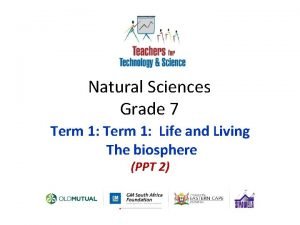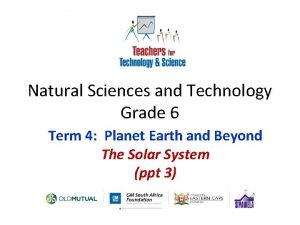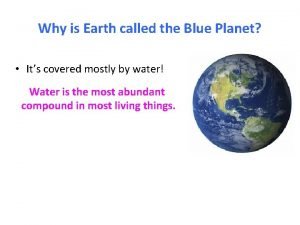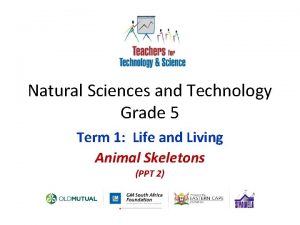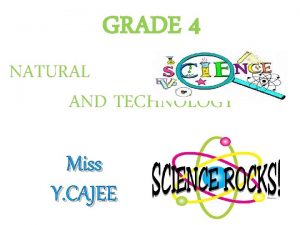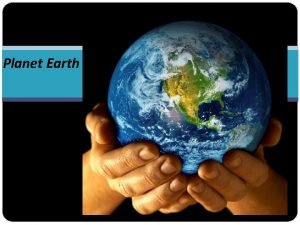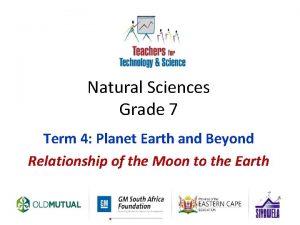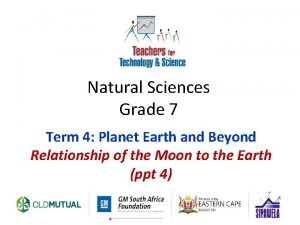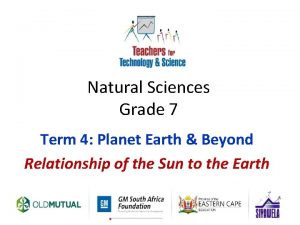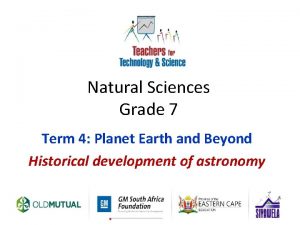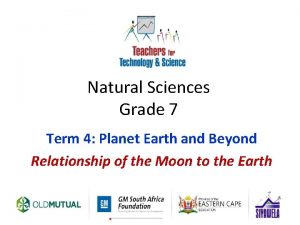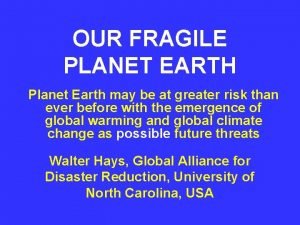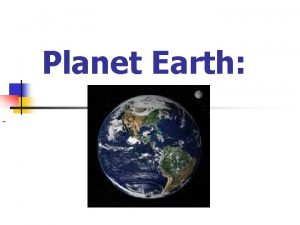Natural Sciences Grade 7 Term 4 Planet Earth



![Nicolaus Copernicus [1473 – 1543] • Renaissance scientist. • In 1514 he claimed that Nicolaus Copernicus [1473 – 1543] • Renaissance scientist. • In 1514 he claimed that](https://slidetodoc.com/presentation_image_h2/4f269a6dbba07b33ffb254398c24a13d/image-4.jpg)
![Galileo Galilei [1564 – 1642] • He used science to gain more information about Galileo Galilei [1564 – 1642] • He used science to gain more information about](https://slidetodoc.com/presentation_image_h2/4f269a6dbba07b33ffb254398c24a13d/image-5.jpg)
![Galileo Galilei [1564 – 1642] • He observed and explained sunspots. • The stars Galileo Galilei [1564 – 1642] • He observed and explained sunspots. • The stars](https://slidetodoc.com/presentation_image_h2/4f269a6dbba07b33ffb254398c24a13d/image-6.jpg)

![Johannes Kepler [1571 – 1630] • He was a German Mathematician. • He observed Johannes Kepler [1571 – 1630] • He was a German Mathematician. • He observed](https://slidetodoc.com/presentation_image_h2/4f269a6dbba07b33ffb254398c24a13d/image-8.jpg)
![Isaac Newton [1642 – 1727] • His gravity law was a very important discovery. Isaac Newton [1642 – 1727] • His gravity law was a very important discovery.](https://slidetodoc.com/presentation_image_h2/4f269a6dbba07b33ffb254398c24a13d/image-9.jpg)
![Isaac Newton [1642 – 1727] • In 1666, at the age of 25, he Isaac Newton [1642 – 1727] • In 1666, at the age of 25, he](https://slidetodoc.com/presentation_image_h2/4f269a6dbba07b33ffb254398c24a13d/image-10.jpg)
- Slides: 10

Natural Sciences Grade 7 Term 4: Planet Earth and Beyond Historical development of astronomy (ppt 2)

Topic 3 Historical development of astronomy Modern developments Natural Sciences - Grade 7

Guess what this is…… Natural Sciences - Grade 7
![Nicolaus Copernicus 1473 1543 Renaissance scientist In 1514 he claimed that Nicolaus Copernicus [1473 – 1543] • Renaissance scientist. • In 1514 he claimed that](https://slidetodoc.com/presentation_image_h2/4f269a6dbba07b33ffb254398c24a13d/image-4.jpg)
Nicolaus Copernicus [1473 – 1543] • Renaissance scientist. • In 1514 he claimed that the Earth revolves around the Sun. • Scientists and religious uproars started. • In 1543 he used Maths geometrical techniques when he discussed the following about his heliocentric model: - Earth’s centre is not the Universe’s centre. - Stars do not move. - Every planet rotates around the Sun. - Celestial bodies do not all revolve around a single point. - The motion of the Earth causes the Sun to move. Natural Sciences - Grade 7
![Galileo Galilei 1564 1642 He used science to gain more information about Galileo Galilei [1564 – 1642] • He used science to gain more information about](https://slidetodoc.com/presentation_image_h2/4f269a6dbba07b33ffb254398c24a13d/image-5.jpg)
Galileo Galilei [1564 – 1642] • He used science to gain more information about the solar system. • He was not the inventor of the telescope, but he was the first scientist who directed it to the sky. • He used it to study the planets and the stars. • He discovered the Milky Way and saw that it was made up of millions of stars; Jupiter’s four biggest moons. After he had constructed an improved 20 x refractor telescope; Venus went through phases that was similar to lunar phases. Natural Sciences - Grade 7
![Galileo Galilei 1564 1642 He observed and explained sunspots The stars Galileo Galilei [1564 – 1642] • He observed and explained sunspots. • The stars](https://slidetodoc.com/presentation_image_h2/4f269a6dbba07b33ffb254398c24a13d/image-6.jpg)
Galileo Galilei [1564 – 1642] • He observed and explained sunspots. • The stars were all at different distances from the Earth. • When he observed the Moon, he discovered that it had valleys, craters and mountains. • He is named the father of observational astronomy. • He spent his life under house arrest due to heresy. • He is the author of Two New Sciences [presently it is called Kinematics and strength of materials]. Natural Sciences - Grade 7

The Orion Constellation • Galileo Galilei viewed the Pleiades [also known as the Seven Sisters and Messier 45] through a telescope. • He discovered that it is an open star cluster in a constellation. Natural Sciences - Grade 7
![Johannes Kepler 1571 1630 He was a German Mathematician He observed Johannes Kepler [1571 – 1630] • He was a German Mathematician. • He observed](https://slidetodoc.com/presentation_image_h2/4f269a6dbba07b33ffb254398c24a13d/image-8.jpg)
Johannes Kepler [1571 – 1630] • He was a German Mathematician. • He observed Mars’ orbit. • He formulated the laws of the planets’ movement in 1609. • He discovered that all the planets moved in elliptical [oval shaped] orbits. • He made a suggestion that Galileo’s telescope work could be used to confirm theory of Nicolaus Copernicus. • There was no distinction between astrology and astronomy in his time. Natural Sciences - Grade 7
![Isaac Newton 1642 1727 His gravity law was a very important discovery Isaac Newton [1642 – 1727] • His gravity law was a very important discovery.](https://slidetodoc.com/presentation_image_h2/4f269a6dbba07b33ffb254398c24a13d/image-9.jpg)
Isaac Newton [1642 – 1727] • His gravity law was a very important discovery. • He explained how gravity kept: - the Earth in its orbit around the Sun. - the Moon in its orbit around the Earth. - objects in the solar system to keep their positions to the Sun. • It started when he noticed an apple falling from a tree; all objects with mass attract each other. Natural Sciences - Grade 7
![Isaac Newton 1642 1727 In 1666 at the age of 25 he Isaac Newton [1642 – 1727] • In 1666, at the age of 25, he](https://slidetodoc.com/presentation_image_h2/4f269a6dbba07b33ffb254398c24a13d/image-10.jpg)
Isaac Newton [1642 – 1727] • In 1666, at the age of 25, he discovered that when white light passes through a prism, it spreads out into a spectrum of seven colours. • The gravity force between two objects become smaller as the distance between the two objects become bigger. • He published a famous article called Principia in 1687 in which calculations were shown that Nicolaus Copernicus was correct. • The Law of Gravitation is universal [planets, stars, galaxies and Moon movements can be predicted by this law]. Natural Sciences - Grade 7
 Natural science grade 7 term 1
Natural science grade 7 term 1 Planet earth and beyond grade 7
Planet earth and beyond grade 7 Natural science energy
Natural science energy Natural science grade 6 solar system
Natural science grade 6 solar system Grade 6 natural science term 2
Grade 6 natural science term 2 Human science
Human science Why the earth is called blue planet
Why the earth is called blue planet Grade 7 ns term 2 worksheets
Grade 7 ns term 2 worksheets Natural science grade 7 notes
Natural science grade 7 notes Natural science grade 5 term 2
Natural science grade 5 term 2 Nst grade 5 term 2 practical
Nst grade 5 term 2 practical
